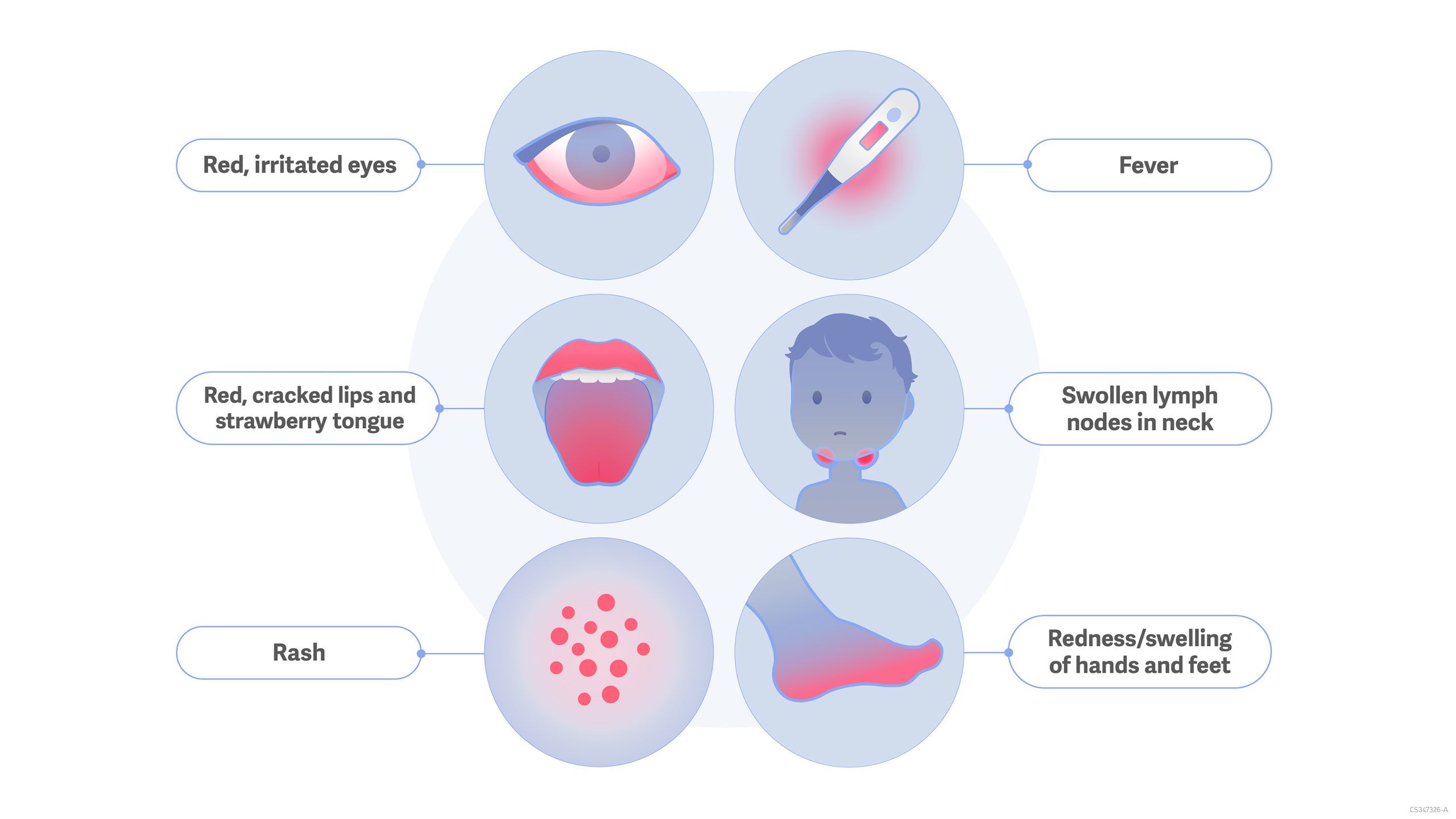Kawasaki Disease: A Novel Respiratory Virus As The Culprit?

Table of Contents
Understanding Kawasaki Disease: Symptoms and Current Theories
Defining Kawasaki Disease:
Kawasaki Disease is an acute, self-limiting vasculitis—an inflammation of blood vessels—that primarily affects children under five years old. It's characterized by a persistent fever and a constellation of other symptoms, making early diagnosis crucial to prevent serious complications, primarily coronary artery aneurysms. The impact on affected children and their families is significant, necessitating a thorough understanding of its pathogenesis.
Clinical Manifestations of KD:
The clinical presentation of Kawasaki Disease is diverse, but some key symptoms consistently appear:
- High Fever: A persistent fever lasting five days or more is the hallmark symptom.
- Rash: A characteristic polymorphous rash often affects the trunk and extremities.
- Conjunctivitis: Bilateral, non-purulent conjunctival injection (redness of the eyes) is common.
- Strawberry Tongue: Inflammation and redness of the tongue with prominent papillae (the characteristic "strawberry" appearance).
- Swollen Lymph Nodes (Lymphadenopathy): Swollen lymph nodes, particularly in the neck, are frequently observed.
- Changes in the Extremities: Swelling and redness of the hands and feet, often followed by peeling of the skin.
Current Theories on Kawasaki Disease Etiology:
While the exact cause of KD remains unknown, several theories have been proposed:
- Genetic Predisposition: Some studies suggest a genetic component, with certain HLA alleles showing an association with increased risk.
- Environmental Factors: Exposure to environmental triggers, such as infectious agents or toxins, has been considered.
- Infectious Triggers: Many researchers believe an infectious agent plays a critical role, although the specific pathogen has yet to be identified. This includes hypotheses involving various bacteria and viruses.
The Case for a Novel Respiratory Virus in Kawasaki Disease
Evidence Linking Respiratory Viruses to KD:
Several epidemiological studies have revealed a strong temporal association between respiratory virus infections and increased incidence of Kawasaki Disease. This correlation suggests a possible link, though further research is needed to establish causality. Specific viruses, such as human herpesvirus 6 (HHV-6) and other respiratory pathogens, have been implicated, but a definitive causative agent remains elusive.
- Studies have shown peaks in KD incidence coinciding with seasonal increases in respiratory infections.
- Detection of certain viral nucleic acids in some KD patients suggests a possible viral involvement, though this isn’t consistent across all cases.
- Increased inflammatory markers often seen in KD patients are also consistent with viral infection.
Characteristics of a Potential Novel Virus:
A novel respiratory virus responsible for Kawasaki Disease might possess the following characteristics:
- Viral Tropism: A preference for infecting vascular endothelial cells, leading to vasculitis.
- Immune Response: The virus might trigger an exaggerated and dysregulated immune response, contributing to the characteristic inflammation.
- Inflammatory Cascade: The virus may initiate an inflammatory cascade that damages blood vessels, leading to the observed complications, especially coronary artery aneurysms.
Research and Ongoing Investigations into Kawasaki Disease
Current Research Efforts:
Scientists are employing advanced techniques to identify potential viral culprits:
- Genome Sequencing: Next-generation sequencing technologies are being used to analyze samples from KD patients to identify novel viruses.
- Viral Identification: Researchers are using various methods to isolate and characterize potential viruses from blood and tissue samples.
- Immunological Studies: Studies are investigating the immune response in KD patients to understand how the immune system reacts to a potential viral infection.
- Cohort Studies: Large-scale cohort studies are tracking KD incidence and correlating it with the prevalence of various respiratory viruses.
Challenges in Identifying the Causative Agent:
Identifying a novel virus responsible for Kawasaki Disease presents significant challenges:
- Heterogeneity of Disease Presentation: The variable symptoms make it difficult to pinpoint a single causative agent.
- Low Viral Load: The virus may be present at low levels, making detection challenging.
- Latency and Reactivation: The virus may have a latent phase, making detection difficult during certain periods.
- Immunocompromised Patients: Variations in individual immune responses may influence disease severity.
Implications of Identifying a Novel Respiratory Virus in Kawasaki Disease
Potential for Prevention and Treatment:
Identifying a novel virus responsible for Kawasaki Disease would have significant implications:
- Vaccine Development: A vaccine could effectively prevent KD, safeguarding children from this potentially debilitating illness.
- Antiviral Treatment: Targeted antiviral therapies could reduce disease severity and prevent complications.
- Prophylactic Measures: Early identification of outbreaks could allow for proactive measures to reduce transmission.
Public Health Implications:
Understanding the viral etiology of KD has crucial public health implications:
- Improved Surveillance: Enhanced surveillance for respiratory viruses could help predict and manage KD outbreaks.
- Disease Surveillance: Integration of KD surveillance with respiratory virus surveillance would aid in early detection and response.
- Pandemic Preparedness: Lessons learned from understanding KD could inform pandemic preparedness strategies.
Conclusion: Towards a Better Understanding of Kawasaki Disease
The evidence increasingly suggests a potential role for a novel respiratory virus in the etiology of Kawasaki Disease. While challenges remain in definitively identifying the causative agent, ongoing research utilizing advanced technologies offers a promising path toward a clearer understanding of this complex condition. Further research into the role of novel respiratory viruses in Kawasaki Disease is crucial for developing effective prevention and treatment strategies. Only through collaborative efforts can we unravel the mysteries of Kawasaki Disease and improve the lives of affected children. Continued investigation into Kawasaki Disease research is paramount to developing effective strategies for prevention and treatment.

Featured Posts
-
 Un Tenista Argentino Odiado Admite La Grandeza De Marcelo Rios En El Tenis
May 30, 2025
Un Tenista Argentino Odiado Admite La Grandeza De Marcelo Rios En El Tenis
May 30, 2025 -
 Impact Of Trumps Tariffs On Indian Solar Energy Equipment Exports A Southeast Asia Focus
May 30, 2025
Impact Of Trumps Tariffs On Indian Solar Energy Equipment Exports A Southeast Asia Focus
May 30, 2025 -
 Portugals President Begins Consultations For Next Prime Minister
May 30, 2025
Portugals President Begins Consultations For Next Prime Minister
May 30, 2025 -
 Explore Z Cars A Deep Dive Into Talking Pictures Tvs Programming
May 30, 2025
Explore Z Cars A Deep Dive Into Talking Pictures Tvs Programming
May 30, 2025 -
 Oi Kalyteres Pasxalines Tileoptikes Metadoseis Sto E Thessalia Gr
May 30, 2025
Oi Kalyteres Pasxalines Tileoptikes Metadoseis Sto E Thessalia Gr
May 30, 2025
